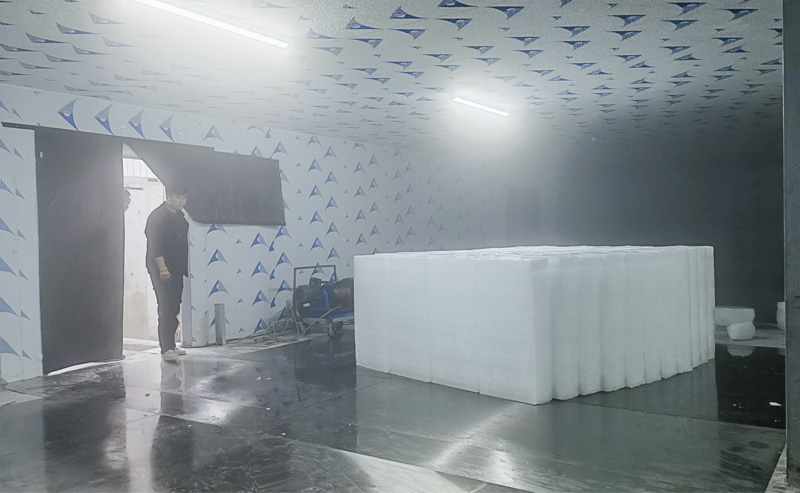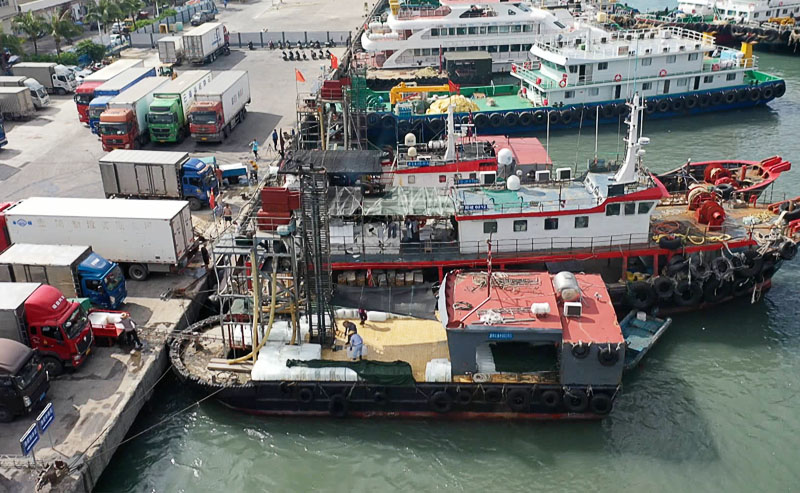 November 22, 2025
November 22, 2025


Un calcul précis de votre consommation quotidienne de glace est la première étape pour choisir la glace adaptée. machine de production de blocs de glace pour votre entreprise de fruits de mer.
Sélectionner le choix approprié machine à glaçons industrielle est crucial pour le fonctionnement des marchés de produits de la mer, où la fraîcheur et la sécurité optimales sont primordiales. machine à congeler les blocs de glace peut avoir un impact significatif sur la qualité des produits, l'efficacité opérationnelle et la rentabilité.
Ce guide complet vous présentera les éléments essentiels à prendre en compte pour choisir le produit idéal. machine à glaçons en blocs Adapté aux besoins spécifiques de votre marché aux produits de la mer, couvrant tout, des calculs de consommation aux spécifications techniques et aux exigences d'installation.

Déterminer précisément vos besoins quotidiens en glace est la première étape essentielle pour choisir un équipement adapté. Une sous-estimation peut entraîner un refroidissement insuffisant et une détérioration des produits, tandis qu'une surestimation engendre des investissements et des coûts d'exploitation inutiles.
Pour les poissonneries, la consommation de glace est principalement liée aux étals de présentation et au transport. Un étal de présentation standard nécessite généralement entre 100 et 150 kg de glace par mètre carré et par jour. Ainsi, une poissonnerie équipée de six étals de 1 m × 1 m aurait besoin d'environ 600 à 900 kg de glace par jour rien que pour la présentation des produits.
De plus, tenez compte de la glace nécessaire pour :
N'oubliez pas que c'est réel capacité de production de glace Les performances peuvent varier considérablement en fonction des conditions environnementales. Comme le souligne un expert du secteur : « Lorsque la température de l’eau est de 30 °C et la température ambiante de 40 °C, de nombreuses machines ne produisent que 40 % de leur capacité nominale. » Cette baisse de performance est particulièrement critique dans les environnements chauds des marchés de produits de la mer et doit être prise en compte dans vos calculs, avec une marge de sécurité de 15 à 20 %.
Prenons l'exemple d'un marché aux fruits de mer de taille moyenne comprenant :
Avec une marge de sécurité de 20 % pour les températures élevées et la demande de pointe : 900 kg × 1,2 = 1 080 kg
Dans ce scénario, vous souhaiteriez sélectionner un machine à glaçons industrielle avec une capacité journalière d'au moins 1 à 1,2 tonne.
Comprendre les différences fondamentales entre bloc de glace et glace en flocons Le choix du système est essentiel pour déterminer celui qui répond le mieux à vos besoins en matière de conservation des produits de la mer.
machines à glace en bloc La glace en blocs produit de gros blocs denses pesant généralement entre 5 et 50 kg. Son principal avantage réside dans son faible rapport surface/volume, ce qui se traduit par une fonte beaucoup plus lente que celle des autres formes de glace. Ce temps de fonte prolongé rend la glace en blocs particulièrement précieuse pour :
Cependant, la glace en blocs nécessite un traitement supplémentaire – le concassage – avant la plupart des applications pour les produits de la mer, ce qui ajoute une étape à votre flux de travail. De plus, les machines représentent généralement un investissement initial plus important et nécessitent plus d'espace au sol. systèmes de glace en flocons.
machines à glace en écailles commerciales La glace en écailles produit des morceaux de glace fins et plats, prêts à l'emploi sans traitement supplémentaire. Ses principaux avantages sont les suivants :
En contrepartie, la glace en écailles fond plus rapidement en raison de sa plus grande surface, ce qui la rend moins adaptée au stockage prolongé ou au transport sur de longues distances.
Pour la plupart des marchés de produits de la mer, une approche intégrée est la plus efficace :
De nombreuses opérations réussies utilisent les deux méthodes, en appliquant chaque type là où ses caractéristiques offrent un avantage maximal tout en minimisant les limitations.

Lors de la sélection de votre machine de production de blocs de glacePlusieurs considérations techniques ont un impact direct sur les performances, l'efficacité et la sécurité.
Le choix du système de réfrigération influe fondamentalement sur son efficacité et sa fiabilité. Les principaux points à prendre en compte sont les suivants :
machines à glaçons industrielles Ces presses sont disponibles en différentes tailles, produisant généralement des blocs de 5 à 50 kg. Les poids standard sont de 5 kg, 10 kg, 15 kg, 20 kg, 25 kg et 50 kg, et des blocs sur mesure de plus grande taille sont disponibles pour des applications spécifiques.
La capacité de production de glace par kilowattheure d'électricité consommée est un calcul crucial pour la rentabilité à long terme. Bien que les données d'efficacité précises varient selon le modèle et le fabricant, les systèmes à refroidissement direct offrent généralement une meilleure efficacité énergétique que les systèmes à saumure traditionnels.
Assurez-vous que tout équipement envisagé possède les certifications de sécurité requises dans votre région, telles que les certifications CE, UL ou NSF. Ces certifications attestent que l'équipement a subi des tests rigoureux de sécurité électrique, de sécurité des matériaux et de conformité aux spécifications de performance.
Une installation correcte a un impact significatif sur les performances, l'efficacité et la durée de vie de l'équipement.
machines à glaçons en blocs nécessitent une planification minutieuse tant pour l'équipement lui-même que pour l'espace de travail environnant :
Les spécifications électriques varient selon la capacité, mais les directives générales comprennent :
Exigences relatives au système d'approvisionnement en eau :
L'environnement opérationnel influe considérablement sur les performances :
Un entretien adéquat est directement lié à la durée de vie des équipements et à leurs performances constantes.
Lors de l'évaluation de modèles spécifiques de machines à glaçons industrielles, utilisez cette liste de contrôle pour garantir une évaluation complète :
Choisir le bon machine à glaçons industrielle Cela nécessite une analyse approfondie de vos besoins opérationnels spécifiques, des contraintes liées à vos installations et des exigences en matière de conservation des produits de la mer. En évaluant systématiquement vos habitudes de consommation, en comprenant les avantages et les inconvénients des différents types de glace et en vérifiant les spécifications techniques, vous pourrez prendre une décision éclairée qui préservera la qualité de vos produits de la mer et votre rentabilité.
Le système optimal allie capacité suffisante et efficacité opérationnelle, assurant un refroidissement fiable au moment et à l'endroit où vous en avez besoin. N'oubliez pas que l'investissement initial le plus faible n'est pas forcément le plus rentable à long terme si l'on tient compte des coûts d'exploitation, des besoins de maintenance et de l'impact potentiel sur la qualité du produit.
Prêt à discuter de vos besoins spécifiques en glace en blocs ? Nos spécialistes techniques peuvent vous aider à calculer vos besoins exacts et à vous recommander la solution optimale. machine à glaçons à refroidissement direct configuration pour votre exploitation de produits de la mer. Contactez-nous Contactez-nous dès aujourd'hui pour une évaluation personnalisée de votre équipement et un devis adapté à vos besoins professionnels.
Nos contacts
Courriel : sales@baocharm.com
WhatsApp : +86 17663537579
WeChat : +86 17663537579
Horaires d'ouverture : du lundi au samedi de 8h30 à 17h30